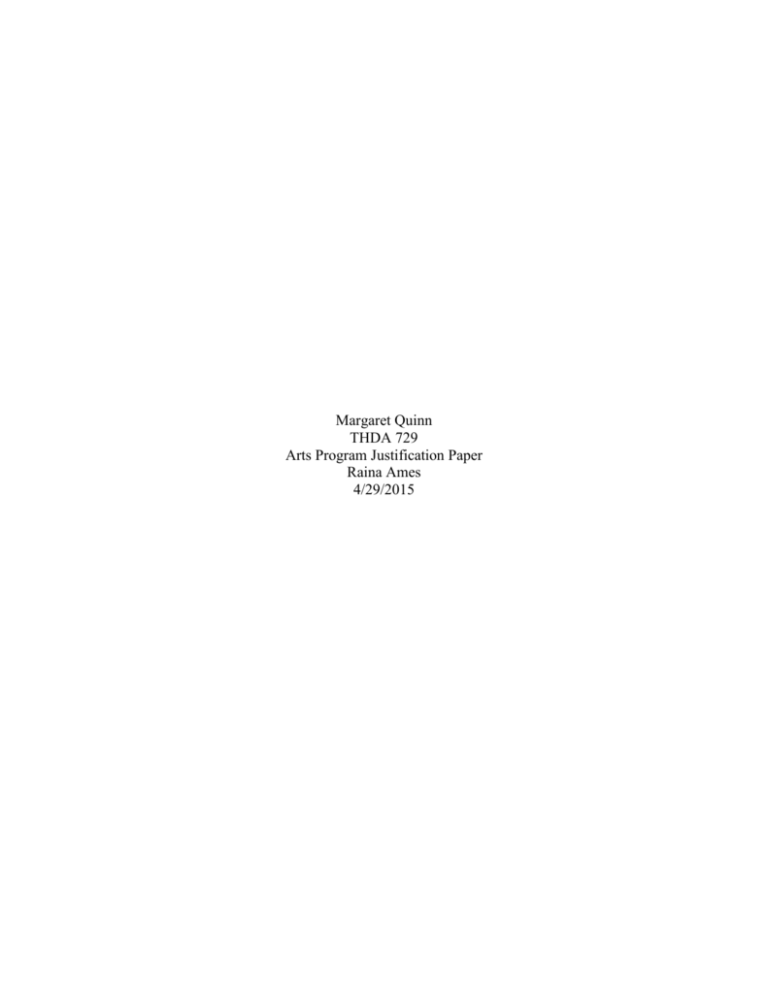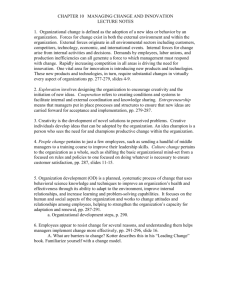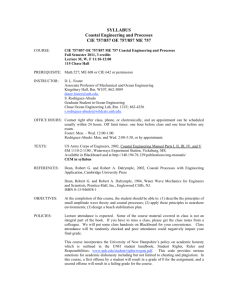Document 9772189
advertisement

Margaret Quinn THDA 729 Arts Program Justification Paper Raina Ames 4/29/2015 Research Justification for Arts Programs Arts Programs in not only secondary schools, but in elementary and middle schools, are extremely important for multiple reasons. The first reason is that there is a high success rate in helping troubled students through the arts. My own experience throughout school attests to that. For example, when I was a very troubled and misunderstood student after my mother died. I was acting out in class and looking for attention from anywhere I could get it. When I joined the drama club during my sophomore year of high school, it was like I found a niche that I fit in to. I went from being one of the most misbehaved students to one of the best-behaved in the school. I went on to become a thespian and to be in my school’s chapter of the National Honor Society. Similar results have been found, different studies saying that, “The arts reach students in ways that they are not otherwise being reached. Other recent educational research has produced insights into different styles of learning. This research also addresses examples of young people who were considered classroom failures, perhaps “acting out” because conventional classroom practices were not engaging them. These “problem” students often became the high-achievers in arts learning settings. Success in the arts became a bridge to learning and eventual success in other areas of learning” (Champions of Change 11). Another example from the same article starts, “To the researchers’ surprise, however, the youth in the arts programs were doing the best. Skeptical about this finding, Heath and her colleagues looked more closely at the arts programs and the youth participating in them. Although the youth in the arts programs were actually at greater “risk” than those in the other programs, the researchers found that characteristics particular to the arts made those programs more effective. They now believe that a combination of “roles, risks, and rules” offered in the arts programs had a greater impact on these young lives” (Champions of Change 10). However, troubled students haven’t been the only students to gain success in the classroom through the use of the arts. Students, no matter if they have learning disabilities, attention deficit disorder, or no problems whatsoever have been noted to be doing better inside and outside the classroom. “… a new GE Fund/MacArthur Foundation report compiles the results of seven major arts education research projects and finds that: 1.) Students with high levels of arts participation outperform “arts-poor” students on virtually every measure. 2.) The arts have a measurable impact on students in “highpoverty” and urban settings. 3.) The arts in after-school programs guide disadvantaged youth toward positive behaviors and goals. 4.) Learning through the arts has significant effects on learning in other domains. 5.) Arts experiences enhance “critical thinking” abilities and outcomes. 6.) The arts enable educators to reach students in effective ways” (Gaining the Arts Advantage 1). This list that researchers put together are just a few of the ways that arts programs can help all students, with disabilities and without. Another important reason why arts programs are essential, especially for secondary education students, is because the programs can give you valuable skills that can be used in the work force when they graduate. “In the global economy, creativity is essential. Today’s workers need more than just skills and knowledge to be productive and innovative participants in the workforce. Just look at the inventors of the iPhone and the developers of Google: they are innovative as well as intelligent. Through their combination of knowledge and creativity, they have transformed the way we communicate, socialize, and do business. Creative experiences are part of the daily work life of engineers, business managers, and hundreds of other professionals. To succeed today and in the future, America’s children will need to be inventive, resourceful, and imaginative. The best way to foster that creativity is through arts education” (President’s Committee of the Arts and the Humanities 11). Creativity should be celebrated and demonstrated throughout school to further and foster the skills that they will use for the rest of his life. Some of the important skills they can learn are teamwork, public speaking, leadership, and many more. For example, “As they engage in the artistic process, children learn that they can observe, organize, and interpret their experiences. They can make decisions, take actions, and monitor the effect of those actions. They can create form and meaning where none existed before. The arts experience becomes a source of communication and interaction for children and adults” (Young Children and the Arts 10). As a future teacher, I am invested in the growth academically of students; and art programs have been shown to improve productivity and student’s grades in certain subjects. “Catterall also found clear evidence that sustained involvement in particular art forms — music and theater — are highly correlated with success in mathematics and reading” (Champions of Change 10). Reading can be hard for children at a young age, in kindergarten through second grade. Using the arts, children can learn memory games and tricks to help improve their reading and writing. It can also give students the motivation to learn to read, and to not become frustrated when they stumble across hard words. “The National Research Council reports that the problems many children face in learning to read could be prevented with high-quality instruction that incorporates a range of language-building activities and early exposure to stories and books. The 1998 report, Preventing Reading Difficulties in Young Children, highlights the importance of games, songs, and poems that emphasize rhyming or manipulation of sounds in developing language skills. It recommends that early childhood professionals understand children’s language development; learn about their sense of story, concepts of space, and fine motor development; and learn how to instill motivation to read” (Young Children and the Arts 9). It is important to realize that arts programs aren’t completely limited to higher education, but that they can be used in elementary school and even before children start coming to school. Arts programs can be introduced to students at younger ages and can help them to learn as they grow up, so that they will be eager and ready to come to school. “A close look at what constitutes the best kind of experience for infants and young children leads quickly to the arts. From a baby’s first lullaby, to a three-year-old’s experimentation with finger paint, to a seven year-old’s dramatization of a favorite story, developmentally appropriate arts experience is critical. For all children, at all ability levels, the arts play a central role in cognitive, motor, language, and socialemotional development. The arts motivate and engage children in learning, stimulate memory and facilitate understanding, enhance symbolic communication, promote relationships, and provide an avenue for building competence” (Young Children and the Arts 7). Arts programs aren’t limited to after-school programs or actual classes – there are ways to use the arts in normal classrooms. The term to describe it is called arts integration. “While the term ‘arts integration’ takes on different meanings to different people, it can be loosely defined as teaching “through” and “with” the arts, creating relationships between different arts disciplines and other classroom skills and subjects (Burnaford, 2007). In recent years, it has formed the basis for several successful school reform initiatives, and has generated a lot of enthusiasm from classroom teachers, school administrators and policy researchers for its ability to produce results” (President’s Committee of the Arts and the Humanities 29). All teachers have the ability to use different arts forms in order to enhance student’s learning capabilities in their classrooms. For example, Arne Duncan, the U.S. Secretary of Education, said, “As a parent, I have witnessed the ability of one arts educator to enrich the learning of my daughter and son, who attend a public elementary school that weaves science throughout the curriculum. The school’s music teacher writes and teaches songs to the kids about science. In his music room, children sing about gravity, sedimentation, rocks, and the planets. Students sing, clap, and dance about solids, liquids, and gases. On holidays celebrating American heroes, Mr. Puzzo writes songs for the students about them. Years later, when students sit down to take their SATs, they report humming Mr. Puzzo’s songs to recall historical and scientific content. These musical experiences provide more than a memorization tool to master facts. They provide opportunities to experience learning in creative ways” (President’s Committee of the Arts and the Humanities 12). The problem facing arts programs is the lack of support in schools from administrators, parents, and other teachers. “…due to budget constraints and emphasis on the subjects of high stakes testing, arts instruction in schools is on a downward trend. Just when they need it most, the classroom tasks and tools that could best reach and inspire these students –– art, music, movement and performing –– are less available to them” (President’s Committee of the Arts and the Humanities 8). With budget cuts targeting arts programs – they are quickly declining across the United States. But I still believe wholeheartedly that they are important, because of cases such as the study, ‘Effects of a Movement Poetry Program on Creativity of Children with Behavioral Disorders’, and how it helped researchers gain momentum towards arts education with results like: “three general results were reported for these two behaviorally disordered children: (a) the boys demonstrated all three creativity variables to varying degrees, (b) growth was both shared and individual: both boys gained interest in poetry, one gained social behavior skills, the other gained motor coordination skills, and (c) both boys enjoyed the program” (Critical Links 16). Another important study, named ‘Assessment of High School Students’ Creative Thinking Skills: A Comparison of the Effects of Dance and Non-dance Classes’, found conclusions such as: “This study suggests a possible relationship between dancing and improved ability to consider multiple perspectives. Such flexible thinking is useful in a range of disciplines” (Critical Links 18). One of the most important studies pertaining to theatre however, is the ‘The Effects of Creative Drama on the Social and Oral Language Skills of Children with Learning Disabilities’ study. This study found that “The children who participated in the creative drama program increased their social skills in all four clusters of social behaviors more than students in the control group. They also significantly improved in their oral expressive language skills when compared with the control group. Receptive language skills (acts of interpreting oral speech of others) were not comparatively affected by the drama program. While these results provide indicators of the helpful effects of dramatic activities on the social and language skills of students with learning disabilities, the follow-up test might be considered to be the most critical element of the research design. In comparison to so many studies that halt operation at the post-assessment, this study tests for sustained effects two months later. All post-measures of language and social skills for the drama group held up over time” (Critical Links 30). These three cases are fantastic examples of why arts education and arts integration are crucial for students throughout their lives – and the affect it can have on their growth and learning processes. I also believe that it is important to appreciate art and people who make it, inside as well as outside of schools. Creating art as a career can be difficult, especially without support from the community. But finally, “…states are recognizing artists and designers as entrepreneurs and innovators. Artists, designers, entertainers, and other “creatives” are likely to be self-employed, and they are constantly creating new products and delivering them to market.11 Armed with startup funding, business training, and professional development support—resources that states regularly provide to entrepreneurs and small businesses in other sectors—artists can expand their markets and add greater value to the economy” (New Engines of Growth 14). A specific instance of this is “…the South Carolina Arts Commission has created a program to fund new arts-based businesses started by South Carolina artists. As part of the state’s Artists’ Ventures Initiative, artists can apply for grants of up to $5,000 to launch a new venture or significantly alter an existing business. Proposals are reviewed by an advisory committee that includes businesspeople as well as experienced artist entrepreneurs” (New Engines of Growth 14). With community support, big steps for arts programs and artists can happen. And if your town, state, or city doesn’t have many arts programs, or there aren’t any implemented into nearby schools – it’s not too late! There are many ways to begin, such as making sure that your town has “a community actively engaged in the arts politics and instructional programs of the district – inside and outside the schools...”, “teachers who practice their art and are encouraged by district administrators to grow in their art as well as in their teaching competence…”, “national, state, and other policies, and programs employed by the district to advance arts education…”, and “continuous improvement in arts education through reflective practices at all school levels…” (Gaining the Arts Advantage 2). It is my belief that is never too late to introduce students to arts through education – and that it all starts with one dedicated individual. From my experiences and research, I’ve found that “…when young people are involved with the arts, something changes in their lives. We’ve often witnessed the rapt expressions on the faces of such young people. Advocates for the arts often use photographs of smiling faces to document the experience. But in a society that values measurements and uses data-driven analysis to inform decisions about allocation of scarce resources, photographs of smiling faces are not enough to gain or even retain support. Such images alone will not convince skeptics or even neutral decision-makers that something exceptional is happening when and where the arts become part of the lives of young people” (Champions of Change 6). Arts education programs can change schools across the world, if we just give it the chance. Bibliography Article 1 (Champions of Change): https://blackboard.unh.edu/bbcswebdav/pid-5074816-dt-content-rid7540644_2/courses/thda729-01-201450/Champions%20Of%20Change.pdf Article 2 (Gaining the Arts Advantage): https://blackboard.unh.edu/bbcswebdav/pid-5074821-dt-content-rid7540649_2/courses/thda729-01-201450/Why%20Your%20Child%20Needs%20the%20Arts.pdf Article 3 (Young Children and the Arts): https://blackboard.unh.edu/bbcswebdav/pid-5074822-dt-content-rid7540650_2/courses/thda729-01-201450/Young%20Children%20and%20the%20Arts.pdf Article 4 (Parent’s Committee on the Arts and Humanities): https://blackboard.unh.edu/bbcswebdav/pid-5074828-dt-content-rid7540655_2/courses/thda729-01-201450/Reinvesting%20in%20Arts%20Education.pdf Article 5 (New Engines of Growth): https://blackboard.unh.edu/bbcswebdav/pid-5074826-dt-content-rid7540653_2/courses/thda729-01-201450/New%20Engines%20of%20GrowthFive%20Roles%20for%20Arts%2C%20Culture%20and%20Design.PDF Article 6 (Critical Links): https://blackboard.unh.edu/bbcswebdav/pid-5074818-dt-content-rid7540646_2/courses/thda729-01-201450/Learning%20in%20the%20Arts.pdf


